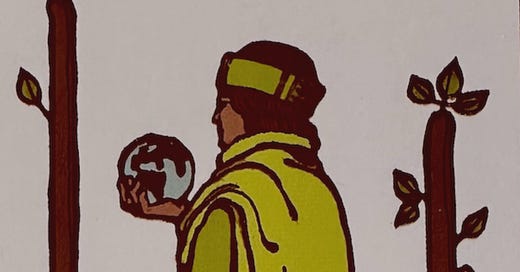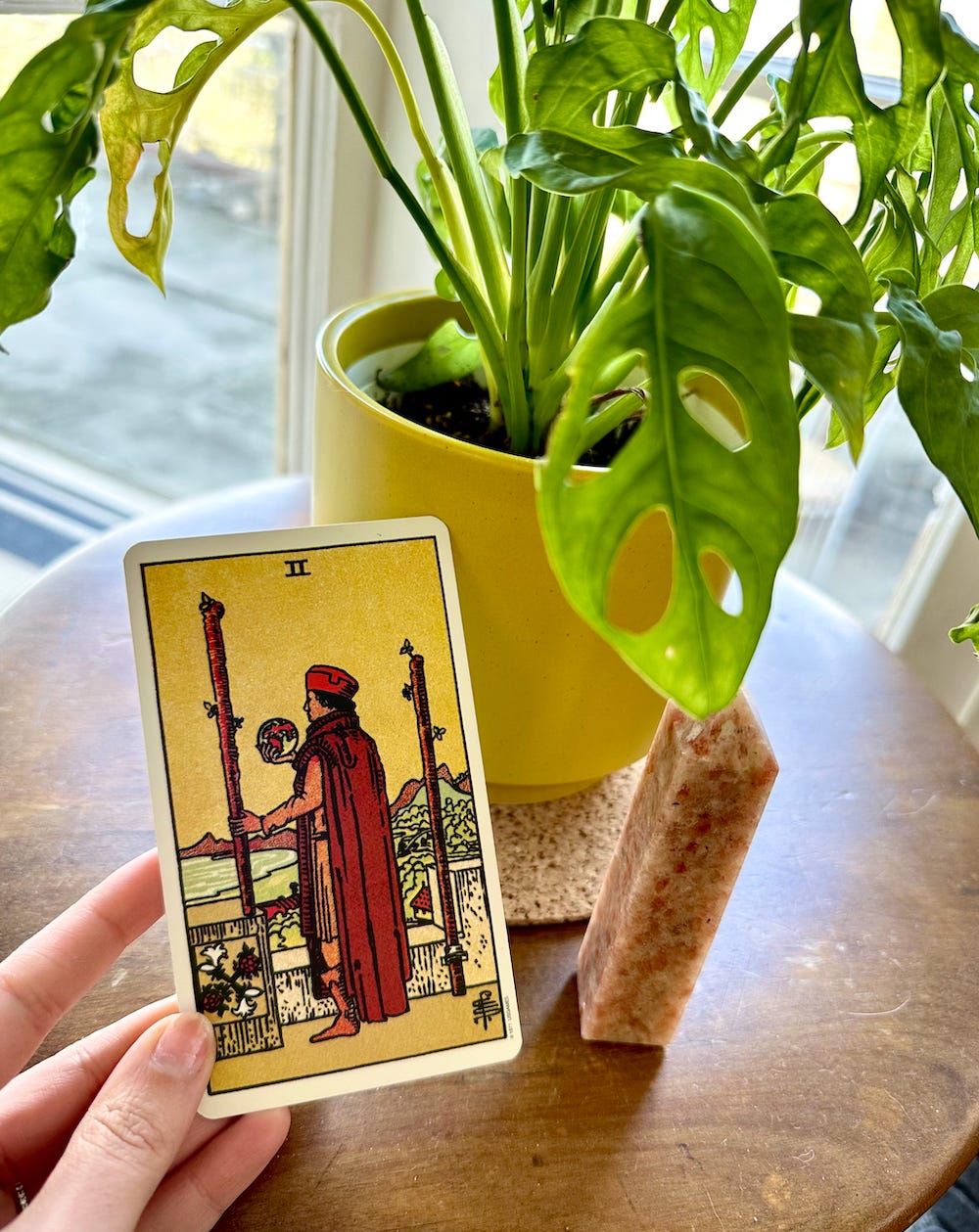That Was Yesterday
Or, how the 2 of Wands helps us put the past in its proper place
Rather listen to this newsletter than read it? Scroll to the end for the audio! This special feature is available to paid subscribers only. Thank you for your support!
Over the last few years, it seems like every time the glow of January begins to paint the horizon, two competing but equally extreme camps emerge in the spiritual and self-help corners of the Internet.
On the one hand we have the hyper-masculine “January 1st sets the tone for the rest of the year so you better go to the gym and not eat a single gram of sugar or screw anything else up or your entire year will be fucked” crowd.
And on the other, we have the seemingly softer but just as bullying hyper-feminine “How dare you set a single resolution for yourself other than being completely gentle and reflective and nurturing your inner child, you self-loathing capitalistic monster” crowd.
And, if you’re like me, you’re probably somewhere in between the two wondering if there isn’t some less unhinged way you can alchemize the global despair that exists inside all of us into new hope and motivation for the year ahead.
For me, this healthy goal-setting and planning for a new year without completely neglecting the impact of the previous year on our psyches and wellbeing is captured in the Two of Wands, one of my top five favorite tarot cards, as mentioned here and probably elsewhere.
In the Rider-Waite-Smith version of the Two of Wands, we see a figure standing on a balcony. In one hand, he holds a wand - a symbol of the element fire, which governs our creative energy and passion. In the other hand, he holds a globe as he looks out into the distance. This far-off gaze overlooking the vast sea, paired with the globe - a literal microcosm - in his hand can be interpreted to indicate a dreamy visioning and planning phase.
When the Two of Wands appears in a tarot reading, we are often being invited to dream big and start drawing up some plans. In the words of Meg Jones Wall in Finding the Fool:
…the Two of Wands creates space for out-of-the-box thinking, for bold ideas and unique strategies, for authentic reflection. This is a crossroads of manifestation, an opportunity to do something different: we don’t have to pursue our vision the same way that everyone else does, use the same old road map or resources or tools. Instead, this is a chance to dream big, to truly blaze our own trail…”
The endless possibilities of this card - not to mention the call for planning and organization - make it a uniquely perfect combination of my dreamy Pisces sun and my pragmatic Virgo moon. No wonder I love it so much.
But there’s something else I want to talk about. And that’s the second wand in this tarot card.
Behind the figure in this tarot card is a second wand that is interestingly propped up or fastened to the castle wall. Although the figure neither faces this wand nor holds it as he does the first, he seems to be aware that it’s there behind him close at hand.
And this, my friends, is why I think the Two of Wands can help us reconcile the new-year desire to completely reinvent ourselves with the baggage from the past that makes that much easier said than done.
If the wand held by the figure in the Two of Wands represents our vision and potential for the future, the second wand on the wall behind the figure represents our past.
Hear me out.
First, the figure’s back is to this second wand. In other words, it’s behind him, which in time means the past.
Next, and perhaps the most curious detail for me, is that this second wand is fastened to the wall, or fixed. Just like our past. We can’t change our past. It happened and it is what it is. It’s there trailing behind us everywhere we go. We can’t erase it or get rid of it, try as we might. And that means, for better or worse, we can always turn around and analyze it, even obsess over it if we like. Because it’s not going anywhere.
The Two of Wands tarot card, however, asks us how useful that would be. This tarot card seems to insist that, given the choice to look back or ahead, we should probably opt to look ahead, especially when it comes to our life’s dreams and plans for our future.
The limbo we experience as we stand between our past experiences, limitations, even regrets on the one hand and our limitless future potential on the other hand is quite appropriate for this time of the year, mythologically speaking.
Do you know where the month of January gets its name? The first month of the year is named after Janus, the Roman god of transitions, doorways, and beginnings. He is represented as a god with two faces, one that looks forward and one that looks back. (Fun fact: Janus is one of the few uniquely Roman gods. That is, he has no earlier Greek counterpart.)
While the two faces of Janus have oft been depicted in illustrations and even ancient coins as identical to one another, the version of Janus that most profoundly speaks to me is when the face looking back is that of an older, bearded man and the face looking forward is that of a young man.
Why does this matter? Because for me, it sheds light on the meaning of looking back and the spiritually nourishing role the past can play in our lives when we learn to regard it and interact with it effectively.
My tarot-fluent brain, and perhaps yours too, cannot read about reflection and looking back without thinking of the Hermit. Especially since the Hermit, just like the backwards-facing Janus, is traditionally depicted as an old, bearded man. In archetypal mythology, a visual and symbolic language, the quickest and often most potent way to depict the wisdom attained with time, age, and life experience - at least to the collective Western mind - is an old man with a beard. (This is even what God himself looks like if my grandmother’s bible and the stained glass windows of the Armenian church have anything to say about it.)
In the Hermit tarot card, we see a cloaked old man with a beard standing in solitude, lighting the path before him with a lantern. It’s as if all the knowledge he has gathered over the years is what fuels the glow of his lantern. This wisdom from his past, like his walking staff, is also something he can lean on to move forward.
In fact, I’d argue that the Hermit archetype is much more prevalent as an old giver of wisdom rather than a recluse. Gandalf and Merlin come to mind. As Rachel Pollack confirms in Seventy Eight Degrees of Wisdom, “Countless stories, especially the Grail legends, depict the hermit who acts as a giver of wisdom to the knight on a spiritual quest.” She goes on to share that psychoanalyst Carl Jung and his followers have also recorded numerous patients’ dreams as including “wise old men guiding them on mysterious journeys into the psyche.”
And finally, as the Major Arcana card that initiates the Fool’s journey into the inner self (as opposed to the external one he has been on thus far), Pollack concludes, “The Hermit signifies a transition.”
Just like Janus does.
We cannot ignore the reflective, past-embracing aspect of transitional archetypes like Janus and the Hermit. Both of these archetypes reveal the value in looking back on how far we have come and celebrating the knowledge we’ve attained and the memories we’ve made.
But most importantly, it is becoming quite clear to me in the myth of Janus, the Hermit archetype, and even the Two of Wands tarot card that the most spiritually nourishing role of the past is always to strengthen, guide, and illuminate our path into the future.
The truth is that if we don’t look ahead and harbor some kind of goal or aspiration for the future, we stagnate. Some plan or hope or dream is necessary for survival. If animals don’t move, they die. We can’t just resign. In the words of author Melody Beattie writing about co-creating with the Divine, “This helps you do your part. It is an affirmation that you’re interested in fully living life.”
And this interest in fully living life, in looking at a map of the world or over a vast ocean and allowing ourselves to dream, is what keeps us spiritually vibrant and vivacious. I’d argue it’s why Janus’s forward-looking face is so youthful.
Once we’ve extracted the wisdom and strength we can from the past, we need to let it go. Because the past is not evidence of what is possible for us in the future. How things have turned out in the past is not necessarily proof of how things will turn out in the future.
Sure, we may have gotten things wrong in the past.
But that was yesterday.
Sure, hurdles and obstacles may have gotten the best of us in certain endeavors in the past.
But that was yesterday.
And yes, we all have disappointment - even devastation - speckling our past.
But that was yesterday.
That was yesterday, and this is today. And there’s no telling what kind of tomorrow we can create.
Below are seven tarot questions to choose from when you are feeling particularly caught up in the past and could use some gentle reflection as a form of self-care to help propel you forward when the time is right. You could ask all of them in one sitting and do a super reflective mega-spread. Or, just pick one or two that feel particularly resonant right now.
Here they are:







